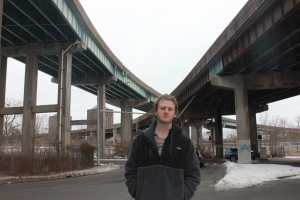Growing up in West Hartford with an interest in architecture and city planning, Jim Krueger often wondered why engineers and city leaders decades ago designed a major interstate highway that cut right through the heart of Hartford, separating the city’s downtown from surrounding neighborhoods and making it easy for drivers to zip right through the capital city without so much as a second thought.
In a new podcast, “The Road That Killed A City,” Krueger examines how the construction of I-84 in the mid-20th century transformed and divided Hartford, creating challenges that the city still deals with to this day.
Krueger, who studied journalism at Penn State University, did much of his research for the podcast at the Hartford History Center at Hartford Public Library. And one of his interviewees was Hartford Public Library board member Steve Harris, a lifelong resident of the city’s North End who saw firsthand the transformation of the city.
“I did some general interviews but the Hartford History Center had lots of documents from people at that time that stated, pretty bluntly, what they were trying to do,” Krueger said of his research. “These legal documents, state documents, they really show people’s intention at the time.”
The podcast project was a labor of love for Krueger, who began work on it in the fall of 2019 and completed the six-episode series in late 2021. He said he hopes it gives listeners an understanding of how some of the challenges Hartford faces were created by short-sighted urban planning and top-down decisions from city leaders who didn’t consult with the residents whose lives they were upending.
“The highway really made it so that people living in the suburbs could literally drive over the poor neighborhoods in Hartford that have kind of been forgotten about,” he said. “When you don’t see something or deal with something head on, when you can just kind of drive past it, regardless of how close you live to it, it’s not your problem anymore and I think that has created a really big lack of empathy for the city.”
Krueger said he was surprised to discover frank discussions by planners in documents at the Hartford History Center about how the highway would not only help Hartford connect to its growing suburbs and stay competitive with other, larger cities, but also achieve the effect of separating downtown from neighborhoods seen as less desirable.
Robert Moses, an urban planner from New York who served as a consultant on highway and development projects in Hartford, wrote in a 1949 planning document that locating the highway through the “slum area north of the business section would be preferable.” The change demolished much of the city’s low-income housing and created a physical barrier between Downtown and the diverse, working-class North End that exists to this day.
“This is the opportunity to accomplish at once slum clearance, rehousing and business and industrious development,” Moses wrote.
“I think I went out to make a podcast that was solely about bad city planning, a botched city planning job, I didn’t know how much race would be tied into it,” Krueger said.
For more information about the podcast, visit www.theroadthatkilledacity.com.
